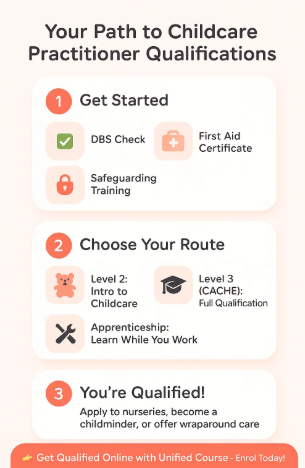If you’ve Googled childcare practitioner qualifications and ended up more confused than when you started, don’t worry—you’re not alone. Let’s break down what each qualification means and how to choose the right one for you. The main thing to know? To become a childcare practitioner in the UK, you’ll need a mix of basic training, a DBS check, and most likely a Level 3 childcare qualification. That’s it. Let’s walk through it step-by-step.
What Does a Childcare Practitioner Do?
A childcare practitioner works with babies and young children to support their development. This includes feeding, playing, teaching basic skills, and keeping them safe. It can be in a nursery, preschool, or at someone’s home. Some people call them nursery nurses or early years workers. Whatever the job title, the goal is the same: help children grow and thrive.
What Qualifications Do You Need To Be a Childcare Practitioner?
The main qualification most employers want is called the CACHE Level 3 Diploma for the Early Years Workforce. CACHE is just the name of the awarding body. This Level 3 course teaches you how to care for kids under 5 and covers everything from playtime to first aid. It’s hands-on, flexible, and respected by nurseries across the UK.
Some people start with a Level 2 course. That’s like a beginner’s version of Level 3. You might study things like child development, health and safety, and helping kids learn through play. Once you pass Level 2, you can move on to Level 3.
You can also qualify through an apprenticeship. That means you work in a nursery while learning on the job. It’s perfect if you want to earn while you study. You’ll still work toward your Level 2 or 3 qualification, just without sitting in a classroom all the time.
No matter the route, you’ll also need a DBS check (to make sure you’re safe to work with kids), a paediatric first aid certificate, and safeguarding training. These are must-haves before starting the job.
How To Become a Child Practitioner (Step by Step)
- Step 1: Get a DBS check. It’s done online through your employer or college.
- Step 2: Take a short first aid and safeguarding course. These often come with your training program.
- Step 3: Choose your route. You can study a childcare course full-time at college, or you can apply for an apprenticeship.
- Step 4: Finish your qualification (Level 2 or ideally Level 3). This takes anywhere from 6 months to 2 years.
- Step 5: Apply for jobs. Once you’re qualified, you can work in nurseries, preschools, or as a childminder.
- Step 6: Keep learning! You can go on to Level 4 or even a degree in early childhood education.
Childcare Practitioner Qualifications: Breaking Down the Terms
Let’s explain some of the terms that keep popping up.
- CACHE: The Council for Awards in Care, Health and Education. They issue popular childcare qualifications in the UK.
- Level 2: A starter qualification. Good if you’re new to childcare. Often called “Certificate in Introducing Caring for Children and Young People.”
- Level 3: This is the gold standard. Often called “Diploma for the Early Years Workforce.”
- EYFS: This stands for Early Years Foundation Stage. It’s a framework that explains how to teach and care for children under 5.
- Apprenticeship: A way to learn while you work. You train on the job, earn money, and get qualified at the same time.

Can I Work in Childcare Without a Qualification?
Yes, but only in assistant roles. You can start as a nursery assistant with no formal qualification. But you’ll still need to complete your DBS, safeguarding, and first aid training. Most employers will also expect you to start working toward your Level 2 or 3 once you get the job.
If you’re serious about making childcare a career, getting qualified is the way to go. It opens more doors and usually means better pay.
What If I Want to Care for My Own Child as a Carer?
If your child has a disability or extra needs, you may be seen as their official carer. You don’t need childcare qualifications for this, but you can apply for support like Carer’s Allowance. You can also request a Parent Carer’s Assessment from your local council. This checks what help you need to care for your child.
If you want to be paid as a carer for your own child through a direct payment or personal budget, the council must agree to this. It depends on your child’s care plan and needs.
What Jobs Can I Do With Childcare Practitioner Qualifications?
Here are some of the roles you can get:
- Nursery Practitioner
- Preschool Assistant
- Childminder
- Nanny (if Ofsted-registered)
- Early Years Teaching Assistant
- Playworker
- Room Leader or Nursery Manager (with more experience)
What Does a Childcare Practitioner Earn in the UK?
Pay isn’t sky-high, but it’s enough to grow on. If you’re starting out with no qualifications, you might earn around £15,000 a year. With a Level 3 qualification, the average jumps to about £18,800 a year, which is around £9.50 an hour. Room leaders and nursery managers can earn £25,000 or more. Some early years teachers in schools earn even higher.
What Types of Childcare Count as Work in the UK?
There are many ways to offer or use childcare:
- Nurseries: All-day care for babies and toddlers
- Childminders: Care in someone’s home
- Preschools and playgroups: Short sessions, often part-time
- Nannies: In your home, but must be Ofsted-registered to count as formal childcare
- Wraparound care: After-school or holiday clubs
To be recognised officially, the provider must be Ofsted-registered. That means you can use government support like Tax-Free Childcare or Universal Credit to help pay.
What Are Childcare Costs in the UK?
Childcare in the UK can be pricey. Nursery costs often reach £120–£150 a week, or more in London. Childminders may charge a bit less. Nannies cost more because they care for your child one-on-one.
The good news? The government offers help. If you qualify, you can get 15 or 30 free hours of childcare each week. You might also be eligible for Tax-Free Childcare or childcare support through Universal Credit. If you’re on the legacy Childcare Vouchers scheme, that still works too—but only if you joined before 2018.
What Counts As Childcare Costs?
Any money you pay to a registered provider counts. That includes nursery fees, childminder costs, nannies (if they’re registered), and after-school club fees. You can’t claim support for paying a family member unless they’re a registered childminder and not living with you.
Food, uniforms, or transport don’t usually count as childcare costs unless they’re part of the provider’s bill.
Final Thoughts
Getting qualified in childcare doesn’t have to be confusing. Start with a DBS check, get some basic training, and then pick a course. The Level 3 diploma is the one most nurseries want. If you’re wondering how to become a child practitioner, it’s all about getting experience and the right qualifications. Whether you take a full-time course or train on the job, there’s a path that fits your life. Kids need great carers. If that sounds like you, don’t wait. This could be the start of a job you love.
Enrol in our flexible online Child Care Courses at Unified Course and get qualified your way.




